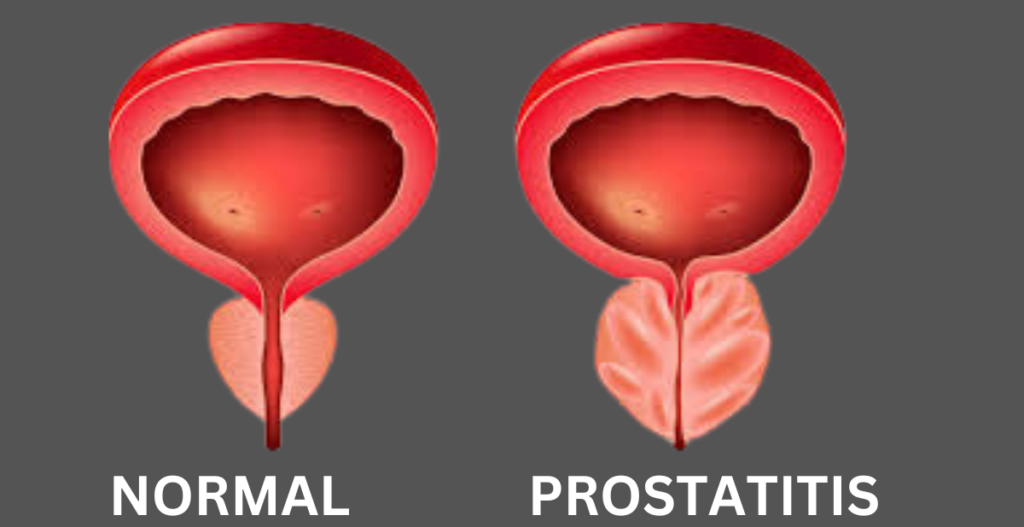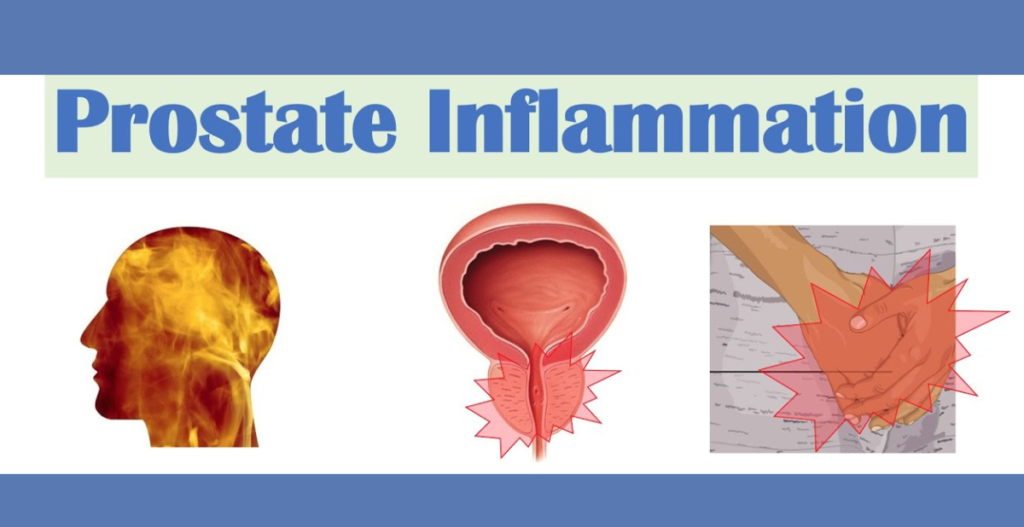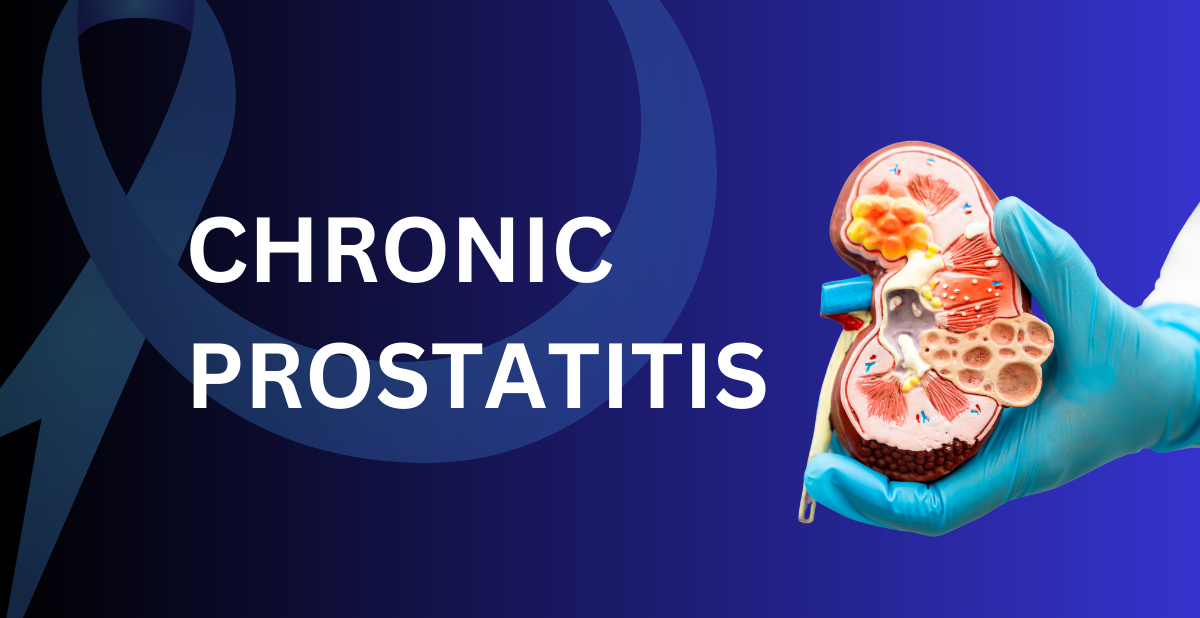Chronic prostatitis is a painful condition that can affect the prostate for up to three months. The disease occurs due to inflammatory inflammation of the prostate. It may impact sexual functioning as well as urinary capacity. The most common cause of this disease is acute prostate infection, by bacteria in the bowel or pelvic nerve. Symptoms of acute prostatic infection are pains that can last for less than three months, True Source reports. In this article, we discuss how to treat chronic prostatitis. This book covers the diagnosis, treatment, and home-based treatments where appropriate.
Is prostatitis a sign of prostate cancer?

It can be mild to severe but can be treated with antibiotics. It does not increase the likelihood of prostate cancer. Prostatic infections can increase levels of antigens in blood as well as prostate tumors and other uncontrolled development of cells. The test results and further tests were needed to identify the cause behind the inflammation of the prostate gland that caused the higher PSA levels.
How common is prostatitis?
Most men experience prostatitis, and a few men experience this. This is the most common serious urinary tract infection or condition in men under 50. In men older than 40, the third highest prevalence. The average person is seen by doctors every year with some type of prostatitis or symptoms of prostatitis.
Who is at risk for prostatitis?
Individuals at risk for prostatitis include:
- Men aged 30 to 50 years old: Prostatitis is more common in this age group, although it can affect men of all ages.
- Men with a history of urinary tract infections (UTIs) or other urological issues.
- Men with an enlarged prostate or benign prostatic hyperplasia (BPH).
- Those who have had a recent bladder infection or urinary catheterization.
- Men with a weakened immune system due to conditions like diabetes, HIV, or ongoing medical treatments like chemotherapy.
- Men who engage in unprotected sexual activity with multiple partners, increase the risk of sexually transmitted infections that can lead to prostatitis.
- Individuals with a history of pelvic trauma or injury, such as from sports or accidents.
It is essential to consult with a healthcare professional if you suspect you may have prostatitis or are experiencing symptoms. Early diagnosis and treatment of prostatitis can help alleviate discomfort and prevent complications.
What causes prostatitis?

Different forms of prostatitis cause different symptoms. There is no evidence that a person diagnosed with prostatitis may have chronic pelvic pain syndrome. Potential contributing factors to diagnose prostatitis include Potential causes of bacterial prostatitis include:
- Bacterial infection: Bacterial prostatitis occurs when bacteria, such as Escherichia coli (E. coli) or other pathogens, enter the prostate gland and cause an infection. These bacteria may reach the prostate through the urinary tract or bloodstream.
- Urinary tract infection (UTI): In some cases, a urinary tract infection can spread to the prostate gland and lead to bacterial prostatitis. Bacteria from the bladder or urethra can travel to the prostate, causing an infection.
- Catheterization or medical procedures: The use of a urinary catheter or certain medical procedures involving the urinary tract can introduce bacteria into the prostate gland, increasing the risk of bacterial prostatitis.
- Urethral infection: Infections of the urethra, such as sexually transmitted infections like gonorrhea or chlamydia, can potentially spread to the prostate and contribute to bacterial prostatitis.
- Anatomical abnormalities: Some individuals may have structural abnormalities in their urinary or reproductive system that make them more susceptible to bacterial prostatitis. These abnormalities can hinder the normal flow of urine and increase the risk of infection.
- Immune system compromise: Individuals with weakened immune systems, such as those with diabetes, HIV/AIDS, or undergoing immunosuppressive therapy, may be more prone to developing bacterial prostatitis due to reduced ability to fight off infections.
- It’s important to note that bacterial prostatitis is different from chronic nonbacterial prostatitis, which does not involve a bacterial infection. Diagnosis and treatment for bacterial prostatitis should be carried out by a healthcare professional.
Symptoms of acute bacterial prostatitis vary by type of disease. In the case of symptomatic inflammatory prostatitis, it is rare for the patient to show a significant improvement — the symptom is not noticeable. Acute bacterial prostatitis may cause fevers and chills in men.
Chronic bacterial prostatitis
Antibiotic therapy usually takes between four and 12 weeks. These types of prostatitis are difficult to treat and can also cause a recurrence of infections. Unless the medication is not working for four to 12 weeks, it can take several weeks or longer for you to take a pill. Occasionally surgery is required if the prostate is removed. Possibly when a patient has difficulty emptying the bladder.
What are the complications of prostatitis?
Those prone to severe bacterial infections develop sepsis syndrome. These extensive inflammations can be deadly. This needs urgent medical care. The antibiotic causes digestive upsets. Symptoms can be very severe and require antibiotics. Some patients have antibiotic resistance which means the medication is not effective. Asymptomatic inflammation prostatitis reduces spermatocyte numbers and negatively affects fertility.
What are the types of prostatitis?
There are four main types of prostatitis, each with distinct characteristics and causes:
- Acute bacterial prostatitis: This type is caused by a bacterial infection and is the least common but most severe form. Symptoms come on suddenly and may include fever, chills, frequent urination, and pain in the lower back or pelvic area. Prompt medical treatment with antibiotics is crucial to prevent complications.
- Chronic bacterial prostatitis: Also caused by a bacterial infection, this form presents with milder symptoms than acute bacterial prostatitis. The symptoms may be ongoing or recur over time. Treatment typically involves long-term antibiotic therapy.
- Chronic pelvic pain syndrome (CPPS) or Chronic nonbacterial prostatitis: This is the most common type of prostatitis, characterized by chronic pelvic pain without any identifiable bacterial infection. The exact cause is often unknown, and treatment may include a combination of medications, physical therapy, and lifestyle changes to manage symptoms.
- Asymptomatic inflammatory prostatitis: In this type, there is inflammation in the prostate without any noticeable symptoms. It is often discovered during tests for other conditions, such as infertility or prostate cancer screening. Treatment is typically not required unless it leads to other issues.
It is essential to consult with a healthcare professional for an accurate diagnosis and appropriate treatment plan if you suspect you may have prostatitis.
How is prostatitis diagnosed?
Diagnosing prostatitis typically involves a combination of medical history, a physical exam and examination, and additional tests. A healthcare professional may perform the following steps to diagnose prostatitis:
- Medical history: The doctor will ask about your symptoms, their duration, and any other relevant medical conditions or history.
- Physical examination: A digital rectal exam (DRE) may be performed, where the doctor inserts a gloved, lubricated finger into the rectum to examine the prostate for tenderness, swelling, or irregularities.
- Urine tests: A urine sample may be collected to check for signs of infection, inflammation, or bacteria.
- Blood tests: Blood samples can be taken to look for signs of infection or inflammation, such as elevated white blood cell counts or elevated C-reactive protein (CRP) levels.
- Prostate-specific antigen (PSA) test: This blood test measures the level of PSA, a protein produced by the prostate gland. Elevated levels can be associated with prostatitis, but they may also indicate other prostate conditions, such as benign prostatic hyperplasia (BPH) or prostate cancer.
- Imaging tests: In some cases, imaging tests like ultrasound or magnetic resonance imaging (MRI) may be used to visualize the prostate and surrounding structures.
- Semen analysis: In certain situations, a semen sample may be examined for signs of inflammation or infection.
- Post-void residual (PVR) urine test: This test measures the amount of urine left in the bladder after urination, which can help identify potential issues with bladder emptying.
Based on the findings from these tests and examinations, a healthcare professional can determine the type and severity of prostatitis and recommend an appropriate treatment plan.
Chronic prostatitis
Chronic prostatitis is a long-term inflammation of the prostate gland, which can cause persistent discomfort or pain in the pelvic region. It is different from acute prostatitis, which has a sudden onset and is often caused by a bacterial infection. Chronic prostatitis can be challenging to diagnose and treat, as the specific cause may not always be identifiable.
There are two main types of chronic prostatitis:
- Chronic bacterial prostatitis: This type is caused by a recurring or persistent bacterial infection in the prostate gland. Symptoms may include frequent urination, painful urination, lower back pain, and pelvic or perineal discomfort. Treatment typically involves long-term antibiotic therapy to eliminate the bacteria causing the infection.
- Chronic pelvic pain syndrome (CPPS) or Chronic nonbacterial prostatitis: This is the most common form of chronic prostatitis and is characterized by ongoing pelvic pain without any identifiable bacterial infection. The exact cause of CPPS is often unknown, and it is thought to be related to factors such as muscle tension, nerve irritation, or autoimmune reactions. Symptoms can include pain in the pelvis, lower back, or genital area, urinary urgency, and frequency, and discomfort during or after ejaculation.
Treatment for chronic nonbacterial prostatitis may involve a combination of approaches, including:
- Pain management with medications like nonsteroidal anti-inflammatory drugs (NSAIDs), muscle relaxants, or alpha-blockers
- Physical therapy to address muscle tension or dysfunction in the pelvic floor
- Lifestyle changes, such as stress reduction techniques, exercise, and dietary adjustments
- Alternative therapies, such as acupuncture or biofeedback
Managing and treatment of chronic prostatitis can be challenging, and it’s essential to work closely with a healthcare professional to develop an individualized treatment plan that addresses the specific symptoms and underlying causes.
How is prostatitis treated?
Treatment depends upon the type of prostatitis. Chronic prostatitis/chronic pelvic pain syndrome. Treatment of chronic pelvic pain syndrome, prostatitis, and pelvic problems will help decrease inflammation and pain, and reduce the risk factors of infection. There are many different symptoms, but none work well for everyone. Although antibiotic therapy does not work for every type of prostatitis alone, the patient may need it for the first few hours until a urologist determines that there are no bacteria. Urologists may prescribe other medications such as alternative therapies are possible.
How is prostatitis chronic pelvic pain syndrome (CPPS) managed or treated?
Treatment for status differs based on the disease’s causes /types. Asymptomatically the inflammation of the prostate does not require medical treatment. If the pain in your pelvis has chronic emphysema, it may require an assessment of the underlying condition. During your appointment, your doctor will use different treatments to treat only the symptoms you have encountered. Around 80 percent of CPPS patients are gaining more benefits through UPOINT technology. The system is concerned with symptoms and treatment.
Medical Tests
A doctor can refer patients to urologists — doctors who specialize in men’s urinary systems. Urologists can diagnose lower urinary tract infections or problems caused by prostatitis and determine the appropriate course of treatment. Medics may use urinary testing in some areas. Urinalysis tests are carried out on urine samples. In some cases, the patients are given urine samples from a doctor’s office or commercial offices in the hospital. Health providers take samples for analysis in the laboratory or at home. For tests, nurses or technicians apply a strip of chemically treated paper known as dipsticks to urine.
How are bacterial forms of prostatitis managed or treated?
Infections caused by prostatitis are often treated with antibiotics. Men with acute bacteria-associated prostatitis need up to 30 days to start receiving an antibiotic in a hospital. Rarely does a man require surgical removal from his prostate gland. Managing chronic bacterial prostatic disease is difficult. During this procedure, the whole prostate tissue is sterilized with antibiotics. Using antibiotics can be used long-term in preventing prostate infections if no surgical treatment is available. Some men require surgical treatment for ureteral stones and scar tissue from their prostates. Rarely is surgery to completely remove prostate ducts (prostatectomy).
What are the 5 warning signs of prostatitis?
Prostatitis can present with a variety of symptoms, and some warning signs may indicate the need for medical attention. Here are five common warning signs of prostatitis:
- Pain or discomfort: Men with prostatitis may experience pain or discomfort in the pelvic region, lower back, perineum (area between the scrotum and rectum), or genitals. The pain may be constant or intermittent and can sometimes worsen during urination or ejaculation.
- Urinary symptoms: Prostatitis can cause urinary issues such as increased frequency, urgency, difficulty starting or maintaining a urine stream, weak urine flow, or a sensation of incomplete bladder emptying. Men may also experience pain or burning during urination.
- Sexual dysfunction: Prostatitis can lead to sexual problems like erectile dysfunction, painful ejaculation, or decreased libido.
- Flu-like symptoms: In cases of acute bacterial prostatitis, men may experience fever, chills, fatigue, and body aches, similar to flu symptoms. This requires immediate medical attention, as it can progress rapidly and lead to severe complications if left untreated.
- Haematuria: Blood in the urine, either visible or detected through lab tests, can be a warning sign of prostatitis or other underlying conditions that require medical evaluation.
If you experience any of these warning signs or suspect you may have prostatitis, it’s essential to consult with a healthcare professional for proper diagnosis and treatment. Early intervention can help alleviate symptoms and prevent complications.
Can prostatitis be cured?
Almost any acute bacterial infection cures in an instant. Sometimes prostatism can still occur when you are cured. Your medical professional may recommend several treatments at once. Sometimes a man has to deal with symptoms to get it gone.
What does it mean if my prostate hurts?
Prostatitis is an abnormal condition on the prostate gland causing inflammation. It may cause discomfort and difficulty with urinating or pain in your pelvis, groin, or genitals. The bacteria cause septicity.
How do you stop prostate pain?
Nonsteroidal anti-inflammatory drugs including ibuprofen, naproxen, and hot soaking baths are good ways to improve the symptoms. Some people are healthier when they have medication to aid bladder and prostate function. The medicines include oxybutynin, doxazosin, prazosin, tamsulin and terazosin.
Where is prostate pain usually felt?
Acute prostatitis/chronic pelvic pain syndrome is a condition in which chronic pelvic pain conditions or discomfort can last for at least three months in any one area. The abdominal region of the upper thighs is hurting.
What are the 5 warning signs of prostate cancer?
If your symptoms include difficulty urinating or vomiting, consult your physician. Often there is unreliable and sluggish urine circulation. Urinates frequently, especially during the night. Problem with resuscitation. Pain in urinating. Blood circulating in urine or skin.
What are the first signs of prostate infection?
Signs: Symptoms. Pain in urinating (disurias). Difficulty in urinating, like dripping or avoiding urining. Often urinating, notably at night (“nocturia”). Urine is essential. The temperature in the air. Blood dripping through urine. A feeling of abdomen and backaches.
What happens if your prostate is infected?
Prostatic infection occurs as the bacterium in a prostate gland and causes the infection. Symptoms are very rapid and may be fever, chill, diarrhea, irritable bowel movements, and pelvis or adjacent zones. Antibiotic treatments are generally helpful for quick relief.
Can prostate infection be treated?
Infective prostatitis can be managed by antibiotic treatments. Several antibiotics which can be used include trimethoprim-sulfamythiazidal sulfamethoxazole Doxycycline Cibrofloxacerine. You may need antibiotics for a month or a week.
What causes infection in the prostate?
Virus-induced infections in prostate glands (UTIs): It is often seen in patients with fevers or chills. You may have urinated very frequently. Acute bacterial prostatitis is urgently treated.
What is the main cause of prostatitis?
How is prostatism caused by pregnancy? Often the infection is acute because of bacteria entering the prostate through the bladder. The ureters include the urinary duct and ureter duct.
How serious is prostatitis?
How does prostatitis cause symptoms? Acute infections can result in the development of sepsis. Extensive inflammation can cause serious health risks. It may require medical attention immediately.
How long does chronic prostatitis last?
Prostatitis can last up to three months. Chronic nonbacterial prostate irritation has been referred to as chronic nonbacterial prostatitis. The reproductive structures include the penis, scrotum, testicular gland, epididymis, vesicula, epithelial cells, and prostate.
Is chronic prostatitis curable?
Usually, prostatitis occurs in women. Symptoms can improve but return without warning. Healthcare companies can’t understand how that happened. It doesn’t work and you’re capable of managing your condition.
How do you detect chronic prostatitis?
Tests for infection may involve a digital rectal examination. The digital rectal exam procedure involves inserting your doctor’s hand in your rectum to detect an inflammable bladder or it can be detected by Urinary test ,Blood testing and Prostate biopsy.
What are the symptoms of acute prostatitis?
Acute bacterial prostatitis. Symptoms. Intestinal rate. Urgent need. Fevers. chill. Burning pain when urinating. Pain in the pelvic region, the pelvic floor muscles, or lower abdominal areas. Nocturia—frequently urinating while sleep. Vomit.
Can acute prostatitis be cured?
In some people, acute bacterial prostatic infection is managed through treatment. Sometimes prostatitis will persist after being treated. The physician might recommend you take multiple medications simultaneously. Some men must live with symptoms as soon as the inflammation is gone. But now with modern Ayurveda, Zyropathy has been introduced -Prostate which cures pathyinflammation, preventing hair loss, and enhancing urinary tract function. This health supplement reduces prostate enlargement and restores normal urinary function.
What is the best treatment for acute prostatitis?
You should be given antibiotics for acute infections of bacteria in prostatic tissue. For severe illness intravenously, intravenous antibiotics can be required for a relatively short time. It is usually 4-6 weeks, or sometimes longer for antibiotics.
How long can acute prostatitis last?
The symptoms typically improve within 2-3 days of treatment. In severe cases, the disease can last up to three weeks.
Is prostatitis curable or not?
Most cases of chronic bacterial prostatitis can be treated. Sometimes the prostatitis symptoms may return once a cure is done. The doctor who diagnoses acute bacterial prostatitis may prescribe several medications. Occasionally men diagnosed with chronic bacterial prostatitis are forced to endure the discomforts until the inflammation is gone.
Is prostatitis easy to cure?
It is often recommended to take antimicrobial medication at a rate of 3 to 6 weeks. It can cause serious complications and infections can come back. When antibiotics do NOT work after 3 or 6 weeks, they can cause serious side effects. So that Zyropathy’s modern Ayurveda has introduced Prostate- A complete care of your prostate naturally. Zyropathy offers, Prostate Health a Natural Botanical Health supplement that is a combination of natural herbal extracts making it very effective in reducing prostate enlargement and solving urinary-related problems.
Can chronic prostatitis be cured?
It is not always easy to cure Prostatitis, but it is still possible to manage its symptoms. It is important for people to follow treatment even if the pain is not as bad. Patients who have prostatitis do not have a higher chance of prostate cancer. I can’t stop my normal sexual behavior because I’m not upset.
What is the main cause of chronic prostatitis?
Chronic bacterial prostatitis occurs when bacteria enter the prostate via the urinary system. The urethra is responsible for the urine culture releasing waste into our bodies. Besides bacterial infections, they may arise through an infection originating in the bladder and the use of the bladder for urine flow or urinary catheter only.
Is chronic prostatitis lifelong?
Prostatitis is a swollen gland on the prostate which causes pain. The symptoms of prostatitis are either chronic or acute. Chronic prostatitis develops slowly and lasts for a year or more. Doctors view prostatitis as chronic if symptoms persist for at least a month.
How do you treat chronic prostatitis?
If you are suffering from bacterial prostatitis, you should be given an antibiotic. Symptoms require IV intravenous antibiotics to stay in a hospital. The entire antibiotic treatment can last from four to six weeks, sometimes more.
Can prostatitis be cured permanently?
In general, prostatic disease is not cured but symptoms may be prevented and controlled by pain medicines. The treatments must continue if they are working on the symptoms. Patients who have prostatitis don’t face a higher chance to get prostate disease.
Does prostatitis heal naturally?
In most cases, an acute infection of prostatitis can be treated using antibiotics. Occasionally severe infection requires hospitalization. Acute prostatitis can be chronic. Symptoms can be reduced by eating healthier foods and lifestyle changes.
What is the fastest way to treat prostatitis?
Nonsteroidal anti-inflammatory medications like ibuprofen, naproxen, and drinking water can relieve chronic pain too. Sometimes a man can feel better if he takes medicine, he thinks is beneficial. These drugs contain the drugs: oxybutynin (doxazosin), prazosin, tamsulosin, and terazosin.
How do you get bacterial prostatitis?
Prostatitis is caused by an infection of the prostate gland. Bacteria enter the prostate gland by infected urine flowing through the bladder. Infections in the prostate gland caused by sex are not caught by partners. During blood tests, urine samples and blood test results contain bacteria.
What is the main cause of bacterial prostatitis?
Biological prostatitis (BP) is usually caused in the intestine of a member of the Enterobacteriaceae family, although organisms from different families can also cause the condition.
What are the symptoms of acute bacterial prostatitis?
Acute bacteria, prostatitis. Urgent need. I am afraid. Chill. A burning sensation during urinatory procedures. Pains of genital areas. Nocturia — frequent urination when asleep. It is nauseating.
Can bacterial prostatitis be treated?
In the case of chronic acute or chronic bacterial prostatitis treatment, it can cause bleeding and is treated with antibiotics. Acute diseases need intravenous (IV) antibiotics in hospitals. The antibiotic treatment generally lasts 4 to 6 months or longer in some circumstances.
How do you get prostatitis infection?
The bacteria that cause urologic problems are known as acute prostatitis. Infection transmitted via sexual contact is often linked to Proteus titis. Among those are chlamydia or gonorrhus.
Is it normal to get prostatitis?
Prostatitis is the most common urinary tract problem for men younger than age 50 and the third most common urinary tract problem for men older than age 50.
Is prostatitis cured?
Acute bacterial prostatitis usually gets treated by therapy. Prostatitis can be found even if treatment fails. Patients with diagnoses of chronic acute bacterial prostatitis should always take multiple doses of medication. Sometimes men will struggle to deal despite suffering severe symptoms until it is healed.
Can prostatitis be harmful?
Men who suffer from acute bacterial prostatitis can suffer from sepsis. The large inflammation of the prostate could cause death. The symptoms must be immediately treated.
What is the best treatment for chronic prostatitis?
Treatment of infections. If it is severe or a persistent infection, the patient may be prescribed antibiotics. Acute diseases may require a very short time in the hospital with an intravenous antibiotic solution. The total antibiotic treatment period can vary from 4 – 6 weeks and sometimes longer.
FAQs
Men who have prostatitis or other urinary symptoms should seek medical assistance. If a woman shows these or other symptoms same urinary tract symptoms also, she must immediately seek medical attention: total non-urinal symptoms. It is difficult to frequent or painful urination, and the pain is intense.
Almost all men suffer from some type of prostatitis, however. It is most commonly seen with older male men. Among those under 50, its third most common among males compared to females ages 45. The number of male prostatitis diagnoses is nearly two million.
Treatment of infections. If your prostatic infection has been aggravated and is bacterially transmitted, you will need antibiotic therapy. For acute diseases, the need of intravenously delivered antibacterial treatment can be prolonged. Normally antibiotic treatment lasts from four months up to six weeks in certain situations.
Dietary changes are important in prostatitis treatment. Consuming whole and natural ingredients helps relieve inflammation, heals the body’s digestive system, and increases immunity. Consists of a regular diet of vegetable foods such as green leaves or cruciferous vegetables.
Symptoms of prostatitis are usually recurrent problems and are easily controlled. Treatments may continue even when your symptoms have improved. Prostate tumors are less common in women with prostatitis.



There are no comments
Comments are closed.